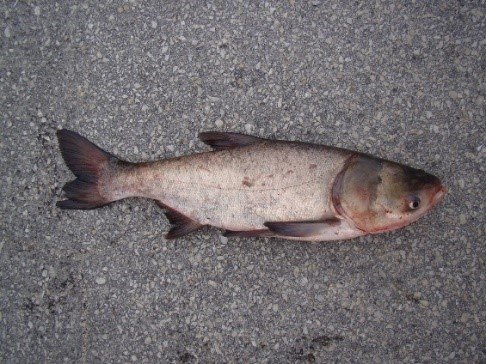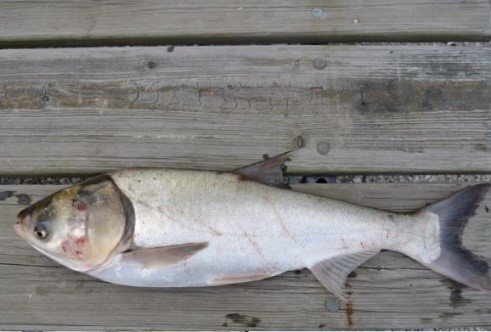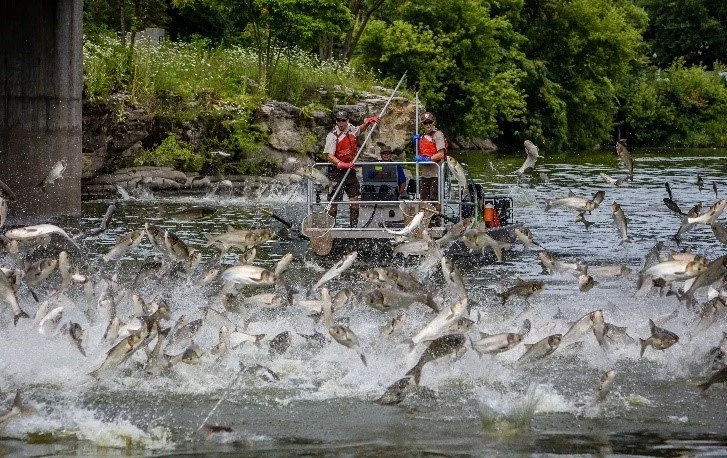A Brief History of Asian Carps
What Are Asian Carps?
Asian carps is a collective term used to refer to four invasive carp species: Grass Carp, Black Carp, Silver Carp, and Bighead Carp. These four species belong to the Cyprinidae family and are closely related to other types of carps and minnows. Asian carps are a threat to Canada and have the potential to cause harm to the environment, economy, and aquatic-related industries in Canada if they were to establish. They would also outcompete our native species. Risk assessments have determined that of the four species of Asian carps, Grass Carp pose the most immediate threat to Canadian waters due to their current proximity.
The Threat to Canada's Fishing Industry
Through competition for food, resources, and habitat, Asian carps threaten the health of Canada’s freshwater ecosystems and the native fish species that depend on them for survival. Because each of the four species has unique diets and displays different behaviours, it is predicted that each species would have unique impacts on the Great Lakes if they were to become established in Canadian waters.
Grass Carp, the most impending and threatening species among the four, are aggressive herbivorous eaters that can weigh up to 80 lbs and consume up to 40% of their body weight in aquatic vegetation each day. This feeding behaviour would have devastating impacts on native fish species, including popular sport fishes, by decreasing this vital resource. High impacts are predicted for 33 fish species in the Great Lakes, including Smallmouth bass and Walleye, because of reduced vegetation and wetland habitat. Aquatic vegetation plays a major role in providing native fish species with shelter, habitat, refuge from predators, protected nesting sites, oxygen, and food.
Silver Carp Jumping - Photo by the Invasive Carp Regional Coordinating Committee
Silver Carp Jumping - Photo by the Invasive Carp Regional Coordinating Committee
Bighead and Silver Carp exclusively eat plankton and do so with minimal restraint; both species have adapted specialized gill rakers for effective filter feeding and lack a true stomach. This requires them to eat almost continuously! This is problematic as plankton is the base of aquatic life and maintains stability within aquatic food chains. The absence or decrease of this resource could result in the loss of native fish biodiversity within the Great Lakes.
Silver Carp and Bighead Carp are very robust and heavy fishes capable of reaching sizes beyond 90 lbs. As a result of their large sizes, density of their schools, and rigorous movement, these species can damage fishing gear, nets, and watercraft. Silver Carp have been known to jump out of the water, reaching heights of up to three meters! This behaviour is likely the result of Silver Carp being sensitive to vibrations in the water caused by boat propellers. Silver Carp are a physical hazard for boaters and have already caused injuries where they have become established. These types of impacts could lead to increases in operating and maintenance costs and a reduction in participation in the boating and fishing industries
Where Did They Come From, and Where Are They Now?
Grass Carp, Black Carp, Bighead Carp, and Silver Carp are all native to the rivers, reservoirs, and lakes of southern Russia and China. During the late 1960s and 1970s, Asian carps were introduced in the southern U.S. as a biocontrol method in aquaculture facilities based on the diets of each species.
Bighead and Silver Carp feed primarily on plankton and were used for maintaining water quality. Black Carp was used for managing unwanted mussel populations, and Grass Carp were preferred for their ability to consume unwanted algae and aquatic vegetation in vast quantities. Not long after they were introduced, flooding events allowed the four species to escape these facilities and move beyond contained environments into open freshwater systems such as the Mississippi River Basin and its tributaries.
Today, Asian carps can even be found as far north as the Illinois River and its tributaries, where they have now become established. The spread of Grass Carp has been the result of intentional stocking for aquatic vegetation management. In the absence of adequate prevention, it is predicted that Asian carps will eventually reach the Great Lakes. Although few rare individual captures have taken place in the Great Lakes, there are currently no reproducing populations of Asian carps in Canadian waters.
Asian carps prefer cold or moderate water temperatures, like that of the Great Lakes, reproduce rapidly, are problematic to native fish due to their specific diets, and make poor prey targets for native predators due to their rapid growth rates and robust size. All Asian carps can reach weights beyond 80 lbs and some species can reach lengths surpassing one meter!
Silver Carp adult held next to juveniles for size comparison – photo by the Invasive Carp Regional Coordinating Committee
What is being done?
Many agencies across Canada and the United States are working to prevent these invasive carps from becoming established in the Great Lakes. Fisheries and Oceans Canada (DFO) does extensive early detection surveillance at up to 37 high-risk locations throughout the Great Lakes for Grass Carp every year. The Ontario Ministry of Natural Resources and Forestry conducts eDNA (environmental DNA) sampling to test the waters for traces of Asian carp DNA. There are also many American agencies working on monitoring and prevention on the U.S. side of the Great Lakes, and research on Grass Carp biology and prevention is ongoing, on both sides of the border.
What You Can Do to Help!
In Canada, it is illegal to trade, buy, or sell Asian carps unless they are dead and eviscerated (gutted). Asian carps are currently not established in Canadian waters, and we want to keep it that way! The best defense in preventing the introduction of Asian carps is to learn how to properly identify the four species (especially Grass Carp), as well as how to report suspected sightings or captures. If you are an active boater or angler, visit the Grass Carp Identification and Reporting Guide to learn more and download.
Visit www.asiancarp.ca for more information.
Links for Further Reading:
Grass Carp Identification and Reporting Guide: https://www.asiancarp.ca/grass-carp-identification-and-reporting-guide/
Confused With Carp: A Guide to Differentiating Asian Carps from Common Look-A-Likes: https://www.asiancarp.ca/asian-carps/confused-with-carp/
Department of Fisheries and Oceans Asian Carp Profile: https://www.dfo-mpo.gc.ca/species-especes/profiles-profils/asiancarp-carpeasiatique-eng.html
ACC Grass Carp Species Profile: https://www.asiancarp.ca/asian-carps/grass-carp/
ACC Black Carp Species Profile: https://www.asiancarp.ca/asian-carps/black-carp/
ACC Silver Carp Species Profile: https://www.asiancarp.ca/asian-carps/silver-carp/
ACC Bighead Carp Species Profile: https://www.asiancarp.ca/asian-carps/bighead-carp/








